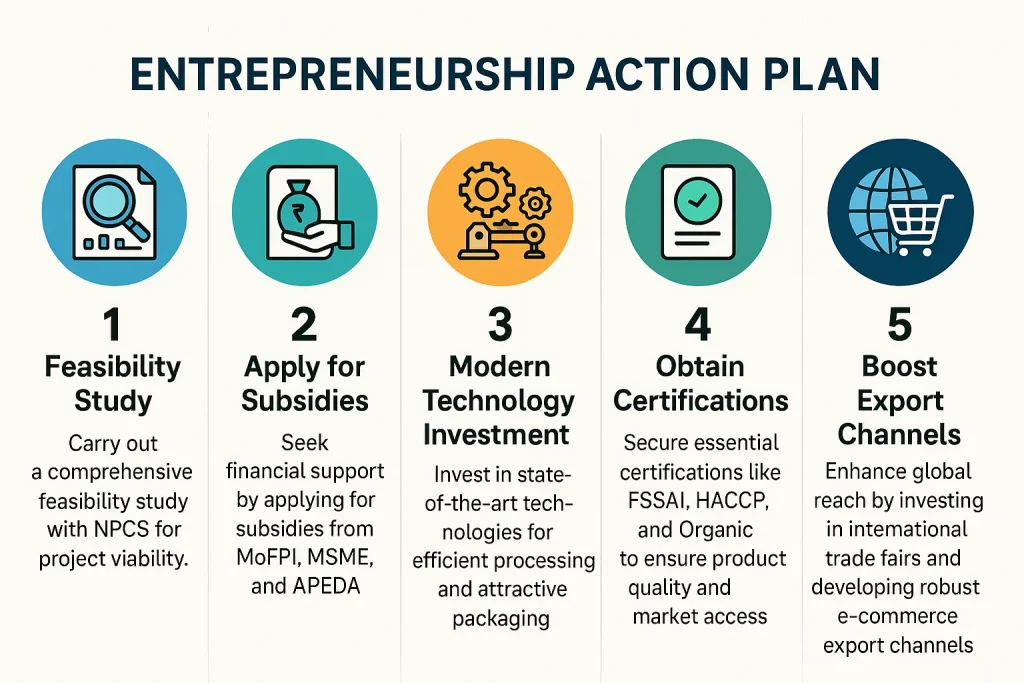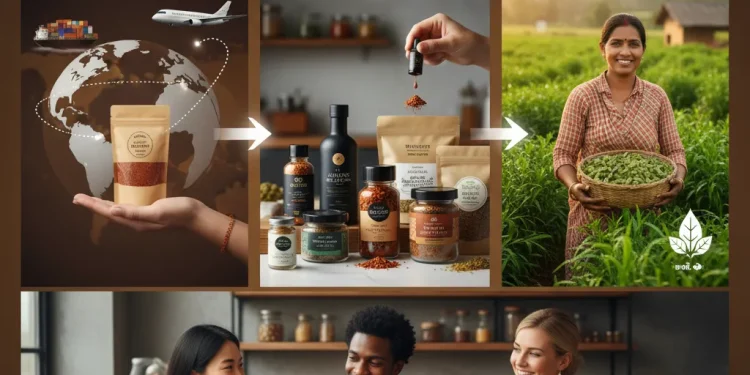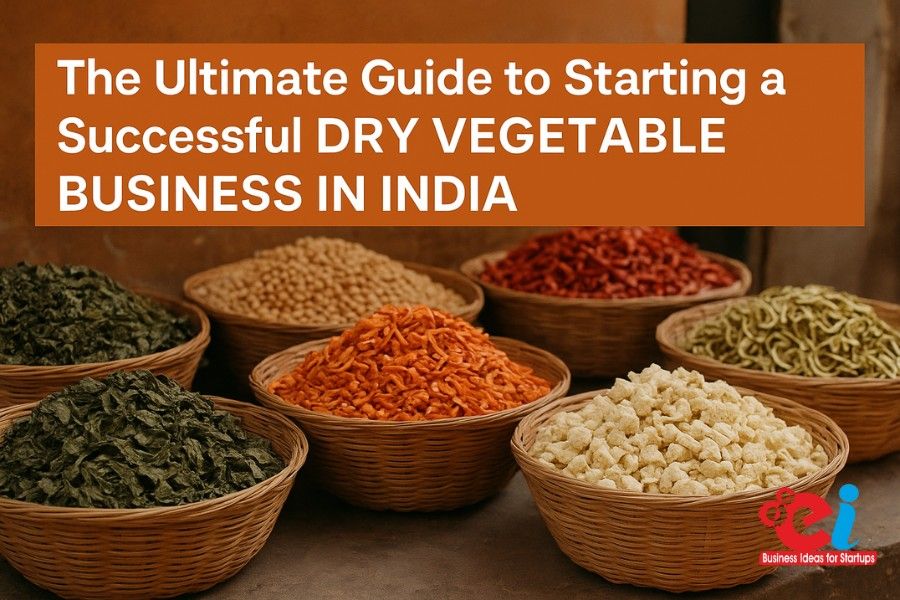Opportunities in Spice Industry: India has always prioritized its spice export trade on turmeric, black pepper, and Indian chilies.
That has changed. As noted in its Annual Report 2023-24, India Spice sold spices worth ₹ 1.25 trillion in the last fiscal, a reflection of diversification in the the spice business along with celery, seed spices, exotic herbs, oleoresins, and fortified blended spices.
This has given the entrepreneurs opportunities well beyond the erstwhile ‘big three’ spices. Using Government of India databank, export data, and some government policies, new entrants set up spices processing and exporting units quite aggressively.
Market Landscape- India’s Growing Spice Export Basket
Investing in the production of new niche spices which face zero competition in India and the world would also lead to new and distinct opportunities. There are some clear reasons for exporting new and niche spice segments.
Higher Price: Rarer spices command a higher price and have a wider profit margin.
Global Demand: There are customers, especially health, gourmet and spice lovers, who seek organic, exotic and functional spices.
Government Support: MoFPI, MoMs, and APEDA all offer sponsorships for exporting promotions, processing, and structuring.
Brand Differentiation: Startups have the ease of developing original brands in areas of minimal competition.
MSME Success Stories – Inspiration for New Entrepreneurs-Opportunities in Spice Industry
Kerala Herb Distillers: Now supplies multinational companies, started with extracting small quantities of essential oils.
Gujarat Celery Processors: Built grading plants with the assistance of APEDA and MSME grants and now conduct global trade.
Rajasthan Organic Spice Firms: Emerged with reinforced and blended unique recipes of spices and exotic herbs, winning shelf space in the premium sector of European supermarkets.
The strategy for new startups is very simple:
- Start with one celery oils niche, exotic herbs or fortified blends.
- For plant setup and certification, avail government subsidies.
- Form partnerships with farmer associations for raw materials.
- Advance to claimed branded exports.
Import–Export Insights – What Can Be Done with Data
India is the leader in exporting turmeric and pepper and recently, exportation of celery, seed spices and other minor spices and herbs have been growing significantly. At the same time, high-value specialty extracts and oleoresins, continue to be imported.
This is where startups can assist:
Identify high demand spices from export data.
Develop domestic plants for the purpose of import substitution.
Export to premium markets, certified, and traceable products.
Expand your product range to include fortified spice blends and extracts to satisfy contemporary consumer needs.
Import–Export Insights – Turning Data into Opportunities
Even though India leads in turmeric and pepper, exports of celery, seed spices and minor herbs are climbing fast. At the same time, many high value oleoresins and specialty extracts are still imported.
This is where startups can step in:
- Use export data to spot rising-demand spices.
- Set up domestic plants for import substitution.
- Export to premium markets certified, traceable products.
- Diversify into fortified spice blends and extracts to meet modern consumer demand.
Most Promising Sectors of the Spice Industry-Opportunities in Spice Industry
The spice industry in India is no longer limited to turmeric, pepper, and chilly. There is opportunity for the addition of more spices. This has opened doors for the new startups. What and how they can prove to be beneficial is discussed and analyzed in this paper.
Celery and Seed Spices
What Makes This Spice Attractive:
The increase in the population has raised the demand for food and consequently for the food, pharmaceuticals, and nutraceuticals.
The export of celery seeds and related products is on the rise.
The imported high purity celery oils.
What is the required Setup:
The units of cleaning, grading, oil extraction and encapsulation.
The How-To-Guide:
With the rising number of celery cultivators, the base facilities can be easily established in Punjab and Himachal Pradesh.
Focus on and ensure high quality domestic production of celery oil to reduce imports of oils.
Exotic Herbs (Basil, Oregano, Rosemary)-Opportunities in Spice Industry
What Makes This Spice Attractive:
There is an increasing demand of gourmet food, nutraceutical blends, and herbal teas.
There is an increase in the export demand for organic dried herbs and essential oils.
What is the required Setup:
There is a need for controlled drying, sterilization, and essential oil extraction.
Sourcing of the required raw materials could be done from the hilly areas farmer clusters.
Sourcing of funds from the MSME schemes while APEDA can be utilized for organic certification and exports promotion, and for entry into the market.
Read More: Manufacturing Business Opportunities in Indian Kitchen Spices
Nutraceuticals Spice Extracts
What Makes It Attractive:
The supply of curcumin/turmeric extract and piperine/pepper extract is one of the booming supplements.
There is an increasing demand and growth in the countries such as the USA, EU, and East Asia.
Set Up Required:
Instalation of solvent extraction, concentration and encapsulation units to obtain high purity extracts.
Playbook for Startups:
Begin with small to mid-sized extraction units.
Global and domestic nutraceutical companies market supply is emphasized.
Take advantage of the purity and affordability of ‘made in India’ products.
Specialty and Fortified Spice Blends-Opportunities in Spice Industry
What Makes It Attractive:
There is a consumer market growth for spices with health benefits and handy.
Some of the examples include Low Sodium Masalas, Turmeric with Vitamin D, and Herbal Marinades.
Set Up Required:
Access to automated micro encapsulated blending plants.
Playbook for Startups:
Make use of the MoFPI product development aids followed by the MSME packaging innovation grants.
Focus on e-commerce exports and domestic retail-Opportunities in Spice Industry.
Differentiate and position as wellness and health branded spice blends.
Essential Oils and Oleoresins
Various Food, and strategic, industrial, and cosmetics and pharmaceutics markets utilize cardamom, clove, celery and spice oleoresins, and oils. The high-value imports indicate strong production capabilities domestically.
Setup Required:
Plants for steam distillation, essential oils and oleoresins, and solvent extraction.
Startup Playbook:
Fuel the venture by first utilizing small scale essential oil extraction. Subsequently, scale into blended formulations and oleoresins. Fast moving consumer goods (FMCG) and cosmetics firms can be approached for strategic marketing partnership as potential bulk purchasers.
Read Our Book: Click Here
Entrepreneurship Action Plan-Opportunities in Spice Industry

Entrepreneurship Action Plan-Opportunities in Spice Industry
- Step one is the completion of a feasibility study involving NPCS.
- Step two is applying for subsidies with MoFPI, MSME, and APEDA.
- Step three is the investment of advanced systems for modern primary processing, secondary packing, and overall improvement of technology.
- Step four is acquiring FSSAI, HACCP, and Organic certifications.
- Use funds from step five, along with investments in trade fairs and e-commerce, to strengthen advanced channels for export.
Future Trends – Beyond Turmeric and Pepper
Add the mix of functional fortification with spices, with added vitamins, probiotics, and medicinal herbs. Use blockchain and QR codes for digital verification and authentication. Implement green processing by using solar drying and other technologies that minimize waste. For direct to consumer (DTC) export, reach buyers through online platforms to sell globally.
Read Our Project Report: Click Here
How NPCS Can Be of Assistance for Opportunities in the Spice Industry
They provide assistance in determining the financial metrics relevant to construction of the designated works including the analysis of requisite market, the capacitance of the business structure and the amalgamation of the offered solutions, the relevant business concentrate equipment.
They also provide the required construction materials, the sightful financial progressively taking construction, and the culmination of the strategy including the insightful business construction and the merged financial plans, along with the help of the vision for spice business startups and their further progress.
Further, NPCS assists in the utilization of the government support schemes for entrepreneurs which, in their absence, would just help in the development and construction of unattained segments of the spice market economy, in their competitive and sustained forms.
Find the Best Idea for Yourself With our Startup Selector Tool
Opportunities in the Spice Industry: Conclusion
Fast growing and worth over ₹1.25 trillion, the spice export sector is an integral part of the economy of India. However, the most potential for future development lies in cellulose, exotic herbs, oleoresins, and fortified spice blends.
Accessing these new segments will allow the new players in the market to set premium prices, reduce the import bill of the country, and issue the growing global demand of the country(Opportunities in Spice Industry).
The next spice revolution of India is possible because of expert guidance from NPCS, government support, and partnerships between India’s farmers and spice entrepreneurs to develop new, high-quality spice businesses-Opportunities in Spice Industry.
Opportunities in Spice Industry: Frequently Asked Questions
Q1. Which spices are the most lucrative for new business entrepreneurs and start-ups?
The high-value and high export spices are celery, exotic herbs, oleoresins, spice extracts, and fortified blends (Opportunities in Spice Industry).
Q2. For setting up a spice processing unit, what is the estimated amount of funding needed?
The cost to setup smaller plants will range from ₹20–50 lakh and ₹1–5 crore for medium-sized extraction plants.
Q3. Do women entrepreneurs have any specific benefits in this sector-Opportunities in Spice Industry?
Yes, there are certain grants available to women entrepreneurs through the PMFME schemes (Opportunities in Spice Industry).
Q4. Which are the mandatory export certifications for spices?
The primary certifications required to access foreign markets for the spices are FSSAI, HACCP, ISO, and Organic certificates (Opportunities in Spice Industry).
Q5. What are the services that NPCS provides to assist businesspersons?
Npcs provides assistance in techno economic feasibility studies, government schemes, detailed project reports, and provides necessary techno economic information-Opportunities in Spice Industry.


























